While smoothies have become a popular meal replacement, snack and all around trendy food, crafted incorrectly you can be consuming a sugar-loaded, blood sugar exploding cocktail. I am excited to share with you A Guide to Smarter Smoothies to hopefully help you understand how to better create the smoothies that are right for you.
If you’ve been reading Tasty Yummies for some time, you probably know that the archives are LOADED with smoothie recipes. Smoothies used to play a much larger role in my daily diet routine, for the longest time it was always my favorite way to start my day. Interestingly at the height of my smoothie consumption, weight loss was definitely a struggle, as were energy crashes and sugar cravings. What I didn’t know back then, but I do know now as a Nutritional Therapy Practitioner, is that without the proper formulation, smoothies are a blood sugar explosion waiting to happen.
Every time you consume any carbohydrates and sugar containing foods, it causes an increase in blood glucose. How much so is dependent on the food and the individual. Simple sugars more specifically (monosaccharides), those sugars ending in -ose, sucrose, glucose, fructose, lactose, galactose, maltose – these are metabolized especially quickly and can often cause a big surge in insulin.
Our body’s innate intelligence continually monitors the amount of glucose in our bloodstream to maintain balance and homeostasis. When blood glucose levels increase, the pancreas releases the hormone insulin. Insulin increases the uptake of glucose by our muscle and fat cells; increases the amount of glycogen in our muscle and liver; increases fatty acid synthesis from excessive carbohydrates; and decreases fat breakdown and mobilization from our fat tissue.
How Bad Can a Fruit-Loaded Smoothie Be?
With a spike in blood sugar, a release of insulin and the impending crash, no matter what food is the initial cause, this can lead to immediate hunger, mid-day cravings, energy crashes, lightheadedness, anxiety, etc. Even worse, if the rest of your day’s eating (and most days) continue on the carb and sugar path, you are absolutely creating a long term problem. Whether you are overweight, struggle with weight loss or notice blood sugar issues or not.
Day in and day out this roller coaster can lead to a slew of health complications beyond obesity, lethargy and cravings. To simplify the worst of it, constant output of insulin is like the boy that cried wolf, your cells stop responding to the insulin that is constantly being produced and they become resistant, meaning without the insulin to transport the excess glucose to your cells for energy production, blood sugar levels remain high and this is can lead to chronic insulin resistance, pre-diabetes and eventually diabetes.
These days, I personally prefer to opt for (and I recommend to my clients) the prioritizing of nutrient-dense whole foods, rather than drinkable meals, like smoothies or juice. Whole foods offer the opportunity for maximum nutrient absorption, which allows our digestion to work as intended, and assuming these whole foods aren’t loaded up with carbohydrates and sugar – it’s much easier on your blood sugar.
That said, in the summer I do find myself with a much different appetite and my cravings differ quite significantly from the cooler months. I am not nearly as ravenous for more robust meals, especially on the hotter days. In the summer months I find myself wanting and craving more smoothies than any other time of the year. Knowing what I know now, my approach to creating them has drastically changed, so today I am going to share with you my Guide to Smarter Smoothies.
Most important when crafting your smoothie, is to be sure you are covering the basic macronutrients, appropriately. A limitation of sugary fruits and other simple fructose-heavy carbohydrates is most important for blood sugar and energy, as well as consequent long term fat storage. Quality fats, proteins and fiber in your smoothies are the most important pieces to the puzzle to be sure you aren’t going to nail your blood sugar with a massive spike. Including nutrient rich, antioxidant loaded greens are also a fabulous way to get the most out of your smoothies.
Digestion
From a digestion standpoint, making sure you are always either under-blending your smoothie ever so slightly to leave a few chunks that require chewing or as I prefer, adding some “crunchies” to the top of your smoothies – this allows your mouth to do some chewing work. This chewing causes the release of salivary enzymes in the mouth, which triggers digestion further down to do it’s job appropriately. This is all vital to making sure that you are able to properly assimilate and break down all the incredible nutrients you are taking the time to include in your smoothie. More on that below.
OK, let’s get to it…
A Guide to Smarter Smoothies
Fat
Fat has little to no effect on blood sugar. When eaten with the other macronutrients (protein and carbs) fat slows down the absorption of these foods, which helps to avoid the massive spikes in blood sugar. Fat keeps you satisfied and satiated for longer, so you can avoid the post-smoothie hanger. Read more about why fat is vital to our health.
+ 1-2 tablespoons of quality fat
coconut meat, butter or oil, mct oil, avocado or avocado oil, cacao butter, ghee, olive oil, pasture raised eggs, nut butters or nuts, tahini
Protein
Works along with fat for satiation and consumed in moderate amounts or alone, it keeps blood sugar steady. Protein is also important to maintaining muscle mass.
+ 20 – 35 grams
You want to always opt for complete proteins, whenever possible. A complete protein contains all 9 amino acids, in a substantial and appropriate quantity and will increase muscle synthesis. Meat, fish and eggs are all complete proteins. While I often add fresh, raw pasture-raised eggs to my smoothies, the former (meat and fish) will clearly not taste so hot in a smoothie. I often use collagen peptides as the protein in my smoothies, Vital Proteins Grass-fed Collagen Peptides (I really enjoy the Vanilla Coconut flavor) you can also opt for Collagen Gelatin or Bone Broth Collagen. While collagen is not a full and complete protein, it is especially high in glycine, proline, and hydroxyproline, the three main amino acids that your body uses to make connective tissue and therefore provides lots of wonderful benefits for healing and recovery, without being technically complete. Read more about the benefits of collagen here. That said not being a complete protein, I wouldn’t recommend collagen as a post-workout recovery protein. You can read more about collagen not being a complete protein here.
These are my personal favorite full and complete protein powders:
Equip Foods Grass-fed Beef Isolate Protein (use that link and coupon code “TASTYYUMMIES“ to save 15%)
PaleoPro Paleo Protein Powder – Grass-fed Beef Isolate, Whole Eggs and Egg Whites (I love that they have a plain unsweetened, unflavored version)
For complete plant based proteins I suggest: Equip Foods Prime Plants, Garden of Life and Thorne’s VegaLite.
If you can tolerate it, a high quality, non-denatured whey protein is truly a great complete protein option. Grass-fed Collagen Whey Protein from Vital Proteins is a quality complete protein and you still get the benefits of the collagen. (They also make Chocolate, Vanilla and Banana Cinnamon flavors). Whey is an isolate of milk, so it doesn’t contain casein or lactose, which are often the causes of many people’s dairy intolerances, so it may be tolerable for some that cannot traditionally do dairy.
Other sources of complete proteins with complete amino acid profiles are beef protein isolate, bovine colostrum, egg protein and casein protein (obviously the latter of these are high allergen/sensitivity risks for those with lactose, casein or egg allergies and intolerances and can also be autoimmune triggers, for some, so choose appropriately).
All of the essential amino acids can be found it plants, but it is rare that one plant can stand alone as a complete protein containing all of them. When looking for quality plant-based protein sources, look for clean, organic sprouted protein powders, pea protein, etc. Pea protein isn’t a complete protein, but it can be combined with other sources to get all of the essential amino acids. While some vegan protein powders are “complete proteins” containing all essential amino acids, often they aren’t in the right amounts, so they aren’t technically complete, and you may want to get the amino acids you are lacking, from other places.
I don’t personally have tons of experience with vegan protein powders, but a few brands I can recommend based on recommendations from fellow NTPs are Garden of Life and Thorne’s VegaLite. While it’s totally possible for vegetarians to get enough protein, it does takes extreme and careful planning and I would be willing to guess that many vegans are not listing and checking off their various amino acids, each day.
Fiber
like fat, fiber slows down the process of sugar absorption in the body. Fiber also promotes healthy gut microbiome proliferation, detoxification, and maintaining the integrity of the gut lining through the production of short-chain fatty acids. To simplify it, fiber keeps things “moving”.
+ up to 1 tablespoon (less if you are adding a very fibrous veggie or fiber-rich foods from the “boost” category)
chia seeds, hemp seeds, avocado, freshly ground flax seeds, acacia fiber, prebiotic fiber blends
Klaire Labs Biotagen, Dr. Formulated Organic Fiber or Organic Acacia Fiber
(on all of these I would recommend a maximum of only 1 teaspoon or two)
For supplemental soluble fibers like prebiotic blends, acacia fiber and even flaxseed, I recommend starting with smaller amounts and gradually increasing. 1/4 teaspoon or so to start and increase a small amount daily. For those that struggle with SIBO, compromised gut flora or general gut dysbiosis, you may experience gastrointestinal upset with certain prebiotic or soluble fibers, I know I have, so you may have to experiment a bit to find the right one and then ease into it.
Leafy Greens, Plants, Veggies, Herbs
A great way to add additional fiber, antioxidants, vitamins and minerals. Each offering differing nutritional profiles. Choose based on what you like most and seasonality – mix it up to change up the nutrients you are receiving.
+ unlimited. As much as you’d like, mix and match.
kale, spinach, chard, collard greens, watercress, bok choy, mustard greens, dandelion greens, parsley, basil, cilantro, mint, thyme, romaine or other lettuces, broccoli sprouts, beet greens, cucumber, fennel, cabbage, cauliflower, broccoli, zucchini (PS raw zucchini brings some serious creaminess, FYI), etc.
Fresh or Frozen Whole Fruit or Starchy / Higher Carbohydrate Vegetables
These are added both for flavor and small amount of sweetness along with additional micronutrients, antioxidants, minerals, vitamins, etc. Go light here, to avoid blood sugar spikes.
+ limited to 1/4 cup up 1/2 cup if you are still transitioning from higher fruit, sweeter smoothies or more carbohydrate-centric breakfasts
Lower sugar (fructose) fruits are recommended to avoid hits to the blood sugar, insulin spikes and consequent blood sugar drops. Berries are a great low-sugar fruit option, especially blueberries, blackberries and raspberries. Other great options include green apple, pear, kiwi, lemon, lime, grapefruit, cranberries, cantaloupe. If you are going to add banana, they are relatively high in sugar compared to the other fruits listed, so be sure to choose a less ripe banana as the more green they are, the less sugar they contain. For vegetables pumpkin or squash, carrots, beets are all great veggie options for low fructose carbohydrates. When frozen, many of these items listed are a great way to chill and thicken your smoothie.
Notes: consuming the whole fruits with their fiber is easier on blood sugar, then juicing, because when juiced, the fiber is stripped and the sugars are concentrated and you are sending a straight shot of fructose to the blood stream which is metabolized at a much faster rate. Fructose is metabolized by your liver. If your liver is full of glycogen (storage carbohydrate) the fructose is then turned into blood triglycerides and fat. This can cause non-alcoholic fatty liver disease and other metabolic issues such as resistance to the hormones insulin and leptin, which can lead to obesity and diabetes. This is also why we add additional fiber to the smoothie, to slow down any affects on blood sugar from the included fructose. Additionally, it should be noted that while it still contains fiber, dried fruit, does have much more concentrated sugars, gram for gram, when compared to fresh fruit.
**** I definitely don’t want to create the idea that we should vilify or condemn fruit, by any means, because it can have many benefits in a healthful diet, but it is important to note that there are certainly issues with genetic variability. It seems that some people may be able to process fructose more efficiently than others, so some people are definitely more affected, in blood sugar and fat gain when it comes to fruit, than others. Bio-individuality. Take note on how you feel, check your blood sugar if you feel so inclined and be aware and conscious of what works best for you. ****
Liquid
To get that smoothie moving. Avoid sweetened liquids and always look for hidden sugar, gums and other crap.
+ start with 1 cup, adjust as needed
water, unsweetened almond milk, coconut milk, cashew milk, hemp milk or other non-dairy milk, green tea, coconut water. The only juice I would personally recommend is a non-fruit, cold pressed green juice.
Crunchies for Digestion
I always recommend adding something to the top of your smoothie that requires chewing, prior to drinking the actual smoothie. Chewing releases enzymes in the mouth that initiate pre-digestion. This release of salivary enzymes also sends signals to the rest of the digestive tract to release the digestive enzymes, stomach acid, gastrointestinal hormones and other key players necessary to properly break down food and to maximize nutrient absorption. I find with a liquid meal like smoothies, juice or broth, without chewing oftentimes digestion isn’t properly triggered and this is when post-meal bloating and gas can occur. Besides digestive distress, the indigestion isn’t working properly our body isn’t even given the chance to assimilate all the good stuff from your food.
+ 1-2 teaspoons
chia seeds, cacao nibs, unsweetened coconut, sliced nuts, sunflower seeds, hemp seeds, chia seeds, goji berries, paleo granola, etc (see below for more ideas),
Additional Superfoods, Flavors and Other Goodies
Because BOOSTING is fun!
+ as needed / desired (adjust other base ingredients as needed, for example if you add in a couple Brazil nuts, consider taking down your fat to just 1 tablespoon or less)
These are just *some* of my favorite boosts!
- Sea Salt or Pink Himalayan Salt – A nice addition to help balance flavors, plus it provides trace minerals to help balance electrolytes
- Turmeric – anti-inflammatory, antioxidant-rich, free radical-fighting, lowers cholesterol, aids in maintaining healthy digestive system. a 26% daily value in manganese and 16% in iron. It’s also an excellent source of fiber, vitamin B6, potassium, and healthy amounts of vitamin C and magnesium.
- Ginger – soothing to the stomach and anti-nausea, boosts immune-function, fights infection, anti-inflammatory. Has antibacterial, antiviral, antioxidant, and anti-parasitic properties. May temporarily increase thermogenesis (fat storage burning) in your body.1http://articles.mercola.com/sites/articles/archive/2014/06/30/ginger-health-benefits.aspx
- Cocoa, cacao – rich concentrations of beneficial antioxidants and polyphenol known to offer benefits for your heart, blood vessels, brain, nervous system, help in combatting diabetes and other conditions rooted in inflammation. Great source of minerals.
- Pumpkin seeds – rich in omega-3 fatty acids. high in fiber and several minerals including zinc, calcium, magnesium, manganese, iron and copper. Loaded with plant compounds known as phytosterols and free-radical scavenging antioxidants. High levels of vitamin K, vitamin E, and all the B vitamins. May help improve insulin regulation. (https://www.ncbi.nlm.nih.gov/pubmed/21545273())
- Ceylon cinnamon – a great choice for stabilizing blood sugar. Has high amounts of calcium, fiber and manganese, as well as antibacterial, antifungal, antimicrobial, antiviral and antioxidant properties.
- Cayenne – extremely high in Vitamins A and C. It also helps produce hydrochloric acid which acids in digestion and elimination. Cayenne is also a good source of vitamin B6, manganese, niacin, riboflavin, magnesium and iron, as well as potassium, which helps control your heart rate and blood pressure.
- Brazil nuts – just 1 or 2 is all you need. High fat and low protein. Besides healthy fats, they are loaded with antioxidants, fiber, vitamins, and minerals. Excellent source of organic selenium, a powerful antioxidant-boosting mineral that may be beneficial for the prevention of cancer.
- Spirulina – a great source of protein, chlorophyll, trace minerals, vitamins, antioxidants and is also a world class immune system booster. Plus spirulina is known to protect against and detoxify radioactive particles and can help balance your body’s pH (alkalinity).
- Baobab – an excellent source of Vitamin C, calcium, potassium, magnesium and fiber. It has more antioxidants than any other fruit.2https://aduna.com/pages/baobab-benefits
- Moringa – an excellent source of protein, vitamin A, potassium, calcium, iron and vitamin C. Helps to balance hormones and slows aging, fights inflammation, boosts heart health, lowers cholesterol and increases immune function. Moringa is rich in antioxidants including chlorogenic acid, which has been shown to slow cells’ absorption of sugar and to lower blood sugar levels.3https://link.springer.com/article/10.1007%2Fs13197-012-0859-9
- Matcha – contains high levels of antioxidants. Contains protein and is an excellent source of vitamins C and A, fiber and iron. Studies show it has the ability to fight bacteria, viruses and fungi, such as staph infections, hepatitis B and Candida albicans.4https://www.ncbi.nlm.nih.gov/pubmed/23072320
- Goji berry – packed with 18 different amino acids and eight essential amino acids, including isoleucine and tryptophan, Goji berries are one of the highest antioxidant containing fruits in the world, typically containing 2-4 times the amount found in blueberries. Goji berries are an excellent source of trace minerals, 21 to be exact, including zinc, iron, copper, calcium and phosphorous, as well as vitamins B1, B2, B6 and E.5https://bengreenfieldfitness.com/2017/03/the-best-smoothie-ingredients/ Goji berries are a source of fructose, so limit your other fruit to less than 1/4 cup.
- Bee pollen – rich in proteins, including all 22 amino acids, bee pollen is a great source of enzymes and vitamins, including B-complex and folic acid. It’s loaded with minerals, trace minerals, and phytonutrients and it’s been shown to provide relief to seasonal allergies.
- Maca – amino acids, minerals, copper, iron, magnesium, phosphorus. beneficial for reproductive health. Maca has been called “Peru’s Natural Viagra” because of its strong effect on male sexual drive and stamina. As an aphrodisiac, maca has the ability to boost libido both in men and women. For men it has shown to help in endurance . For women it has shown to improve menstruation both in regulation and pain. It can also help fertility and even menopause. Also maca has shown to offer benefits in depression, stress, skin health and more. 6http://articles.mercola.com/herbs-spices/maca.aspx
- Hemp seeds – a great plant-based source of essential fatty acid, with more essential fatty acids than flax or any other nut or seed. Contains phytonutrients, which may boost immunity, purify the skin, and strengthen connective tissue. Plus, hemp is high in protein and contains all 20 amino acids, including the 9 essential amino acids (EAAs) our bodies cannot produce. It’s also high in fiber. Hemp is an amazing source of essential minerals, including magnesium, manganese, and iron.
- Green powders – additional vitamins, minerals, antioxidants and other good stuff, depending on the blend.
- Adaptogenic herbs – ashwaganda, ginseng, holy basil, astragalus root, licorice root, rhodiola. Adaptogens balance and restore the body. They support the adrenals and help to lower cortisol which can increase your capacity to deal with stress and improve your mental and physical performance. 7https://draxe.com/7-adaptogen-herbs-to-lower-cortisol/
- Mushroom/fungus powders – Cordyceps, reishi, lion’s mane, chaga, shiitake and maitake mushrooms are funguses with antioxidant properties. The contain powerful healing properties to boost your immune system and support healthy hormone function. Mushrooms are anti-inflammatory and anti-viral and they work to support healthy liver function, optimize cholesterol levels and provide cancer fighting benefits.
Tips: minimize the amount of blending time to retain maximum nutrient content. Ideally, when making any fresh smoothie with raw vegetables and fruits, it’s best to consume it directly after making to ensure less nutrient loss.
RECIPE IDEAS: If you follow me on Instagram, I often share my smoothie creations in the Instagam Stories area (the feed up top, that lives for 24 hours). I also encourage you to use the hashtag #smartersmoothies to share your creations so we can all inspire each other.
References
| 1. | ↑ | http://articles.mercola.com/sites/articles/archive/2014/06/30/ginger-health-benefits.aspx |
| 2. | ↑ | https://aduna.com/pages/baobab-benefits |
| 3. | ↑ | https://link.springer.com/article/10.1007%2Fs13197-012-0859-9 |
| 4. | ↑ | https://www.ncbi.nlm.nih.gov/pubmed/23072320 |
| 5. | ↑ | https://bengreenfieldfitness.com/2017/03/the-best-smoothie-ingredients/ |
| 6. | ↑ | http://articles.mercola.com/herbs-spices/maca.aspx |
| 7. | ↑ | https://draxe.com/7-adaptogen-herbs-to-lower-cortisol/ |
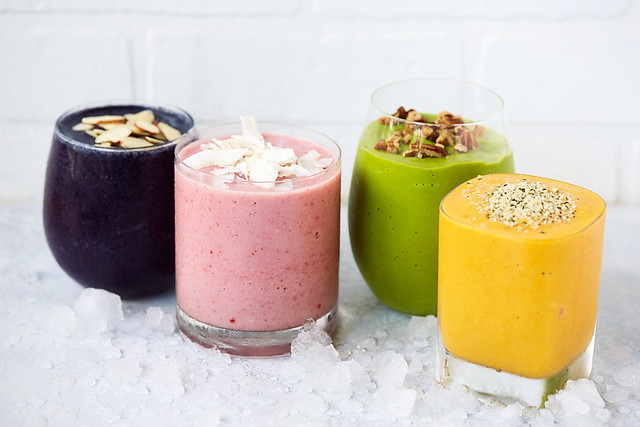
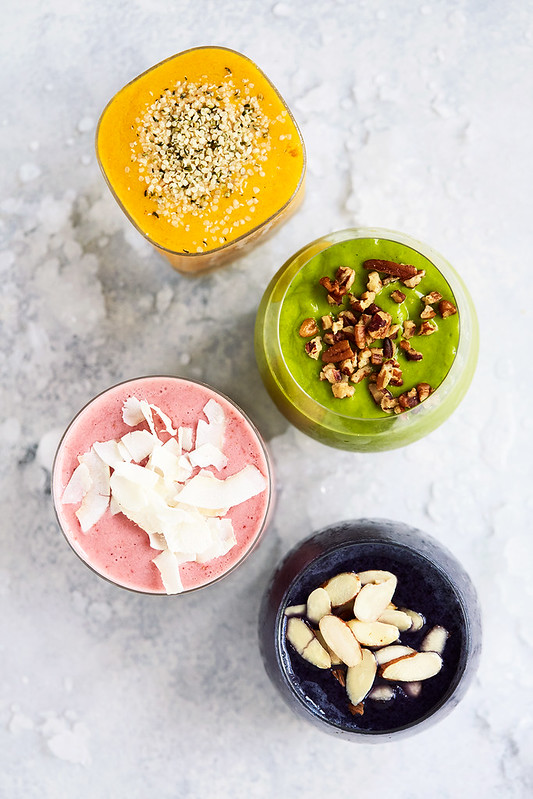

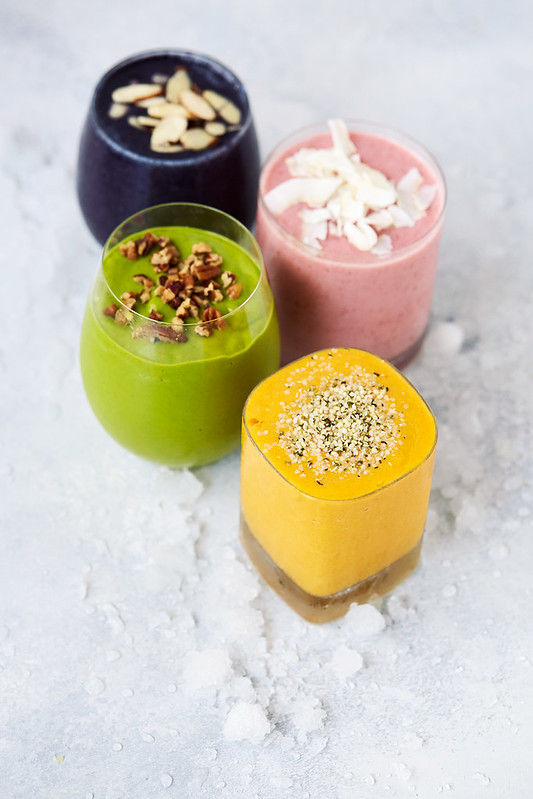
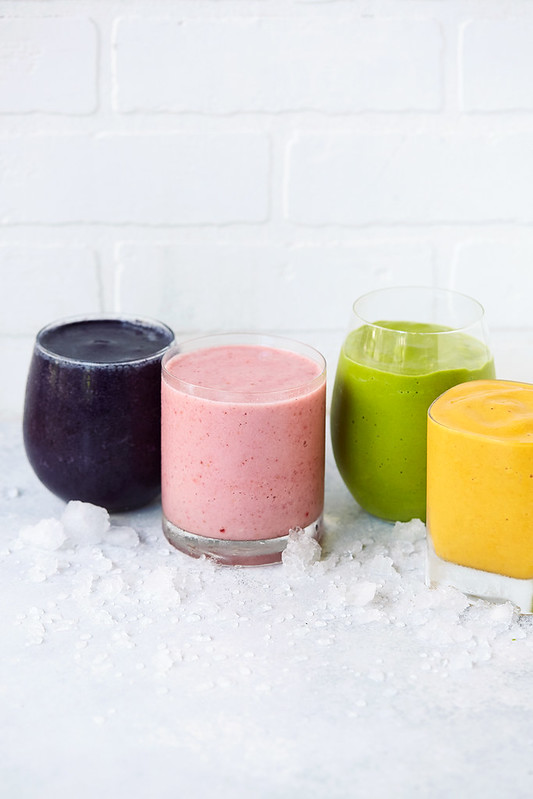
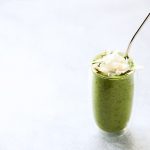
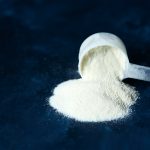
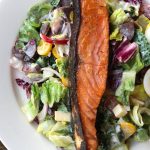
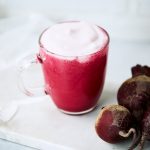

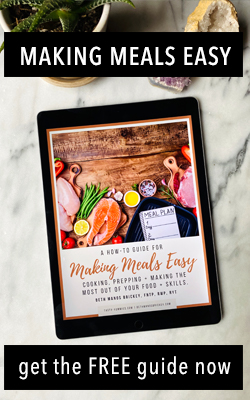
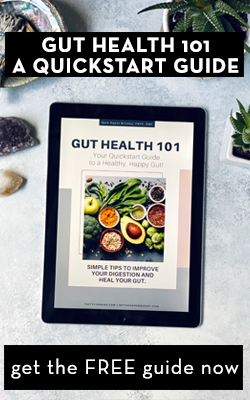




18 Responses
This post is fantastic (thank you!) but I was so hoping it would end with the recipes for those 4 amazing looking smoothies in the photos! Can you share?
Hi Ali, thanks, Glad you like it. There were no specific recipes for those 4 pictures, just thrown together to capture some beautiful shots to compliment the post. Use the formula above and pick what you love most and get creative, you’ll be shocked and what you come up with on your own. If you follow me on Instagram, I am always sharing the smoothie recipes I am crafting, over there on Instagram stories, you can get lots of great ideas, following the formula of this post, there.
I second this comment!! I really wanted the recipes, too! Please share. I loved your post. So informative and well written. 🙂
Thanks Mindy, I am glad you enjoyed the post, as I mentioned to Ali, There were no specific recipes for those 4 pictures, just thrown together more to capture some beautiful shots to compliment the post. Use the formula above and pick what YOU love most and get creative, you’ll be shocked at what you come up with on your own. If you follow me on Instagram (@tastyyummies), I am always sharing the smoothie recipes I am crafting in the mornings, over there on Instagram stories, you can get lots of great ideas, following the formula of this post, there.
This is AMAZING!! I enjoyed this and will continue to. I am such a nerd so I love how you broke everything down so we can really understand the what and why. This is a gem of a tutorial, for both beginners and experienced-smoothie fanatics!
I had been told that green apple is the lowest sugar of the apples, so when I saw green apple listed with the higher sugar fruits I was surprised. I generally use Granny Smith and Pink Lady because of this and additionally on the wall at my grocery store these two kinds are the two lowest down on the a diagram continuum of apple sugars. Are they lying? Thanks for sharing your knowledge with us:)
Hi Lauren, I think you may have misread that area, with the fruit, all of the items listed are lower sugar fruits. Banana is the only one that isn’t a lower sugar fruit, which is why I added the note that a green tipped banana is a better option. Can you reread and tell me if you think I need to edit that paragraph to make it more clear? I want to be sure that it’s understood that all of those fruits listed are good options for lower sugar fruits to add to the smoothie.
And of course, I am so happy that you enjoyed the post so much. I am really nerdy/passionate about all of this so I am glad it’s being so well received. Thank you so much.
Oh yay!! That’s exciting. I do understand what you’re saying now, I think. All of the foods listed other than banana are low sugar options, right? I can see that you were adding banana in to the list of options and telling us how to choose more green to fit with low-sugar agenda, but I misinterpreted it as all the fruits listed after berries and before bananas are higher sugar, which I’m so happy to hear is incorrect! Prior to commenting, I did read that part twice and was still mixed-up. Everything else is super clear and well received on my end 🙂
OK, thank you so much. I really appreciate you reading it again for me. I will edit it to make it even more clear. I can see where it gets a little confusing. I added banana, with the note, because people really LOVE bananas in their smoothies. Thanks again girl.
I am happy to know that I have been doing most of this right! However, I need to moderate the fruits or choose more wisely! I have been starting my day with a smoothie for the past five months (Well, not exactly. I begin with lemon juice and rind, and honey in lukewarm water). I have lost weight and feel more energized. Your article (and all the rest!) encourages me to continue on this path. I am “naturally” making healthier eating choices: organic meat, fruits and vegetables, less meat consumption, more gluten-free foods, etc. I simply love your blog. I have been reading it for the past three years… My daughter is gluten and lactose intolerent, and I have shared your Website with her. Thank you for sharing your knowledge and advice. Thank you for all those wonderful recipes. Please keep it up! Merci beaucoup. Andrée (Quebec, Canada)
Beth, this post is so helpful! Thank you so much for writing this!
Great article! Thanks for pulling all this info together!
This is wonderful! Thank you for the inspiration. I’m almost 8 months pregnant with my second right now so sometimes throwing things into a blender is just my speed. Your ideas are far superior to the smoothies I’ve been making! 🙂 I should print this out and use for the post natal transition too!
So great article! I like to cook Smoothies and do it often.
But now I know how to make it more healthy
Thank you!
Wonderful and helpful article. Question about prepping these smoothies in advance. I need to be out the door by 6 am most days, and prepping and blending in the am won’t always work. The whole point of these smoothies is to get the most nutrition possible, so what do you think I could prep in advance to still get the most benefits? Or, could you freeze blended smoothies to maintain the nutrition? Thanks so much! 😀
Hi Beth! I just saw that Trader Joe’s has an unsweetened Acai pureed packet. https://www.traderjoes.com/digin/post/unsweetened-organic-aa-pure-packets.
What are your thoughts on something like this in place of the lower sugar fruit you mentioned? I personally haven’t experimented much with Acai, but love (low-sugar protein) smoothies as recovery after a workout.
Suzanne
I love this! One of my biggest pet peeves are the ‘healthy smoothie’ recipes people are consuming that are laden with massive fruit amounts (and sometimes JUICE!) and they think it is healthy! All my smoothie recipes are a balance of fruit/veg/protein/fat…..I learned quickly when it was one of the few foods i could get my picky kiddo to eat! Thanks Beth!
I need little flashcards of dos and don’ts so much information to remember. Thank you I now know why I am always starving after a smoothie.
excellent , excellent post!